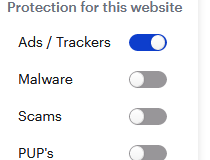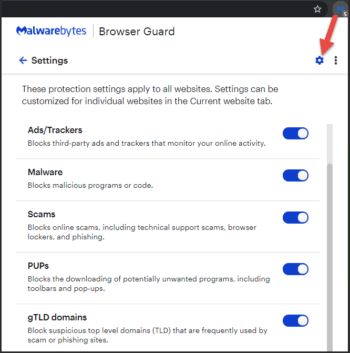
- #Edge malwarebytes browser guard how to
- #Edge malwarebytes browser guard for mac os
- #Edge malwarebytes browser guard password
The image below shows the kind of data that can be collected:Ī critical part of any infostealer operation is the back end server that will receive the stolen data. The attacker's goal is to simply run their program and steal data from victims and then immediately exfiltrate it back to their own server.

#Edge malwarebytes browser guard password
Once executed, it will keep prompting for the user password in a never ending loop until victims finally relent and type it in. The malware is bundled in an ad-hoc signed app meaning it's not an Apple certificate, so it cannot be revoked. Unlike regular apps, it does not need to be copied into the Mac's Apps folder but is simply mounted and executed.
#Edge malwarebytes browser guard how to
The downloaded file ( TradingView.dmg) comes with instructions on how to open it in order to bypass GateKeeper. One way to detect a potential phishing site is by checking when it was created, which in this case was only a few days ago.īoth the Windows and Linux buttons point to an MSIX installer hosted on Discord that drops NetSupport RAT: The Mac download is hosted at: Payload The decoy site (trabingviewscom) looks quite authentic and shows three download buttons: one each for Windows, Mac and Linux. When the user clicks on the ad they are redirected to a phishing page hosted at trabingviewscom: This is likely a compromised ad account that is being used by the threat actors.

Google's Ads Transparency Center page shows this advertiser account belongs to someone from Belarus. The ad below for TradingView uses special font characters ( tradıņgsvıewscom is embedded with unicode characters: trad\u0131\u0146gsv\u0131ewscom) perhaps as an attempt to appear like the real domain and evade detection from Google's ad quality checks: Threat actors are buying ads matching well-known brands and tricking victims into visiting their site as if it were the official page. Users looking to download a new program will naturally turn to Google and run a search. In this blog post, we will provide details on one campaign targeting TradingView, a popular platform and app to track financial markets. The developer has been actively working on the project, releasing a new version at the end of June.Ĭriminals who buy the toolkit have been distributing it mostly via cracked software downloads but are also impersonating legitimate websites and using ads on search engines such as Google to lure victims in.
#Edge malwarebytes browser guard for mac os
However, we recently captured a campaign that was pushing both Windows and Mac malware, the latter being an updated version of the new but popular Atomic Stealer (AMOS) for Mac.ĪMOS was first advertised in April 2023 as a stealer for Mac OS with a strong focus on crypto assets, capable of harvesting passwords from browsers and Apple's keychain, as well as featuring a file grabber. That's not surprising considering that Microsoft holds the largest market share for both desktop and laptop computers.


The majority of the malvertising campaigns we have tracked for the past few months have targeted Windows users. The payload is a new version of the recent Atomic Stealer for OSX.The malware is bundled in an ad-hoc signed app so it cannot be revoked by Apple.Phishing sites trick victims into downloading what they believe is the app they want.Malicious ads for Google searches are targeting Mac users.


 0 kommentar(er)
0 kommentar(er)
